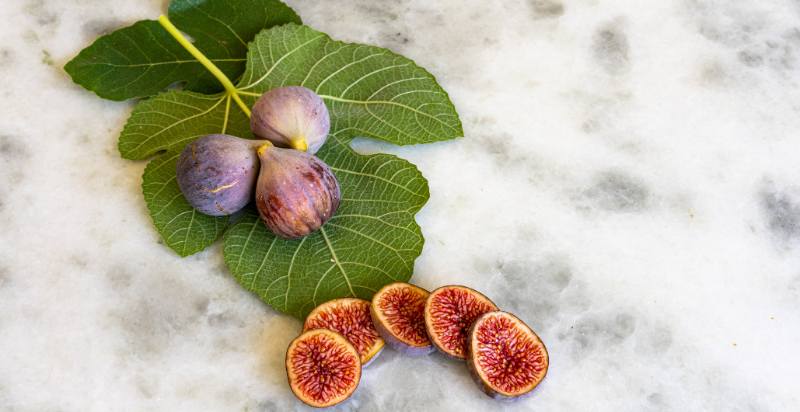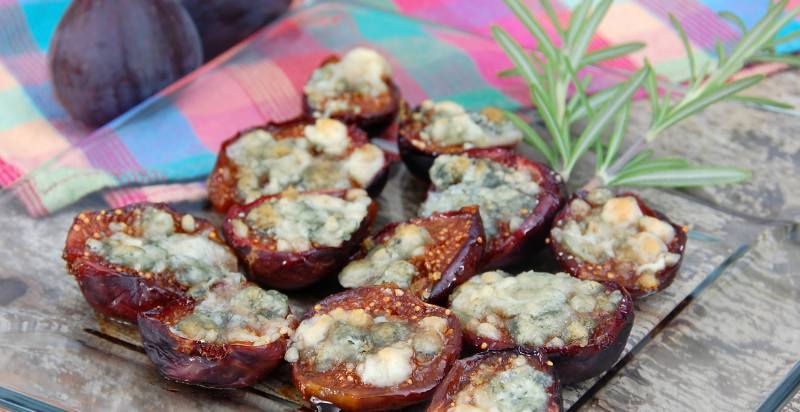Black Mission Figs are an ancient variety of figs native to the Mediterranean. They are sweet and succulent with a unique flavor that can be enjoyed fresh or dried. Black Mission Figs have a long history of being used as an ingredient in desserts, jams, and sauces. They are high in fiber, antioxidants, and various vitamins and minerals. This article will overview Black Mission Figs, including their nutrition profile, health benefits, and culinary uses.
What are Black Mission Figs?
Black Mission figs are a variety of figs that originated in the Mediterranean region and have been cultivated in California since the mid-1800s. They are sweet, dark-skinned fruits with soft flesh and tiny edible seeds. Black Mission Figs have a unique flavor profile and can be used for many dishes. Whether you enjoy them fresh, dried, or as a part of your favorite recipes, Black Mission Figs will surely add flavor and nutrition to any meal.

History and Origin of Black Mission Figs
Black Mission figs, also known as Black Spanish figs, are a variety of common edible figs (Ficus carica) with purplish black skin and sweet red-pink flesh. Native to the Mediterranean region, the origin of this variety is uncertain but believed to be brought over from Spain in the late 1700s or early 1800s by Franciscan missionaries. The trees were planted in California, where the climate and soil proved ideal for their growth and production.
Today, Black Mission figs are among the most popular figs grown in California; they can also be found throughout other parts of Europe and North America. These sweet fruits have a unique flavor that is slightly tart with a hint of honey-like sweetness. The fruit’s skin is slightly rubbery and leathery, making it a great choice for fresh eating and cooking.
Description of the Black Mission Figs
The Black Mission fig tree is an attractive, evergreen plant with large leaves that can reach up to 12 centimeters long and 7 centimeters wide. The flowers of the Black Mission fig are yellow-green, about 1 centimeter in diameter, and arranged in clusters on the branches. This tree can grow up to 5 meters high and produce abundant fruit in summer.
The Black Mission fig is an adaptable plant that can handle hot climates, drought, and most soil types. It does require regular pruning to keep it in shape and encourage new growth and better fruit production. The Black Mission fig is a great addition to any garden or landscape, where it can provide a beautiful, sweet-tasting addition to meals.
Flavor Profile of the Black Mission Figs
Compared to other figs, Black Mission Figs have a sweeter and richer flavor. The flesh is softer and has a rich jammy texture. Although they are well eaten raw, they are often used in baking and cooking due to their high sugar content. The sweetness of the figs pairs well with many flavors, such as honey, hazelnuts, and balsamic vinegar. The flavor of Black Mission Figs is often described as complex and earthy with a hint of sweetness.
The flavor is even more intense when cooked, and they are often used in jams, preserves, and baked goods. Black Mission Figs are a great addition to salads, yogurt parfaits, and savory dishes like stews.
Health Benefits of the Black Mission Figs
The Black Mission Fig contains more vitamins and minerals, such as calcium, potassium, magnesium, and vitamin A. They are an excellent source of dietary fiber, with one serving containing 8 grams. In addition, they are a good source of plant-based proteins and contain many essential amino acids. This makes them a great addition to any vegetarian or vegan diet. Moreover, the antioxidants found in Black Mission figs help protect cells from damage, improving overall health and promoting longevity.
Finally, these figs provide a great energy source for those who engage in physical activity or have an active lifestyle. They can help energize you and provide a quick energy boost when needed. With its many health benefits, Black Mission figs are a great addition to any diet.
Cultivation of the Black Mission Figs
Black Mission figs typically require well-draining, fertile soil with a pH range of 6.0 to 7.0 for optimum growth. The tree should be planted in an area that receives full sun and is sheltered, as figs require consistent warmth for proper fruiting. Plant the tree 10 inches (25 cm) deep in the soil, and water it thoroughly after planting. Figs should be pruned annually to maintain an open form (allowing sunlight penetration).
To promote abundant fruiting, use a balanced fertilizer with nitrogen, phosphorous, and potassium at least twice a year—once during late winter or early spring and again during mid-to-late summer. Water regularly, especially during dry periods, as figs require consistent moisture for optimum growth. Black Mission figs can be harvested from the tree in mid-summer when they are ripe and ready to eat.
Harvesting of the Black Mission Figs
Commercially-grown fig trees, the fruit is harvested when it is ripe, usually around mid-July to August. The earlier harvests are usually processed for drying or canning, while the later ones are sold fresh. Proper harvesting and handling techniques should be followed to ensure that the quality of the fruit is maintained. The fruits can also be frozen for later use.
Figs harvested too early or late may not be of the highest quality and can lose flavor. All ripe figs should be picked from the tree, as they will not continue to ripen after being removed. The stems should be cut with a clean knife or pruners to avoid damage to the fruit. Harvested figs should be refrigerated immediately to prevent spoilage, with the optimal storage temperature being between 34 and 39 degrees Fahrenheit.
Once harvested, figs can be stored for several days in the refrigerator before they need to be used. They should also be handled carefully as they are fragile and easily bruised or damaged. Additionally, inspecting all fruits before use is important as they may contain insects or larvae.

Where Do Black Mission Figs Grow?
Black Mission figs are primarily grown in Mediterranean climates, including California and the western coast of Italy. They can also be found in Southern Europe, North Africa, Israel, Lebanon, Syria, Iraq, Iran, and Turkey. In America, they are mainly produced in California’s Central Coast region, Arizona, New Mexico, and Texas. Some farmers are experimenting with growing Black Mission figs in northern states like Washington and Oregon, but the warm climates are better suited for producing successful crops.
In Australia, they are grown mainly in Western Australia and New South Wales. In India, these figs are widely cultivated as well. Some other countries where Black Mission figs can be found include South Africa, Chile, Peru, and Argentina. With the increasing popularity of these figs, more and more producers are experimenting with different climates to grow them. This has allowed them to be available in various regions across the globe.
What are the Things to Remember when Buying Black Mission Figs?
When buying Black Mission Figs, it is important to remember the following:
- Look for plump, dark-colored figs with glossy skin that yields slightly to the touch. Avoid any that have bruises or soft spots.
- Purchase freshly harvested ripe figs whenever possible, as they are sweetest and most flavorful when at their peak of ripeness.
- Store them in the refrigerator as soon as possible to maintain their freshness and flavor.
- Always check the expiration date on packaged figs before purchasing or consuming them, as they can spoil quickly.
- Consider trying different types of Black Mission Figs, such as Calimyrna, Adriatic, Kadota, etc., to experience a variety of flavors and textures.
These tips will help ensure that your Black Mission Figs are of the best quality and taste.
What is the Best Way to Store Black Mission Figs?
Black Mission Figs should be stored in a cool, dry place away from direct sunlight. They can be kept on the counter or pantry for up to four days if they are ripe. If they are unripe, store them at room temperature for two to three days before refrigerating. The best way to store Black Mission Figs in cm is in an airtight container such as a Tupperware, glass jar, or plastic bag. Make sure to remove excess moisture so that mold does not occur. Refrigerate any ripened figs for up to one week or freeze them for up to six months.
Cut them in half when freezing Black Mission Figs and place them into a freezer-safe bag or container. Label the container with the date it was frozen so you can track how long they have been stored. Frozen figs will last up to six months in the freezer before their flavor diminishes. To enjoy frozen figs, thaw them at room temperature for one hour before eating or adding them to recipes.

How Can Black Mission Figs be used in recipes with other Fruits and Vegetables?
Black Mission figs are extremely versatile and can be used in various dishes. They go particularly well with other fruits, such as apples, pears, grapes, and hearty vegetables, like onions, carrots, and celery. For savory applications, pair them with herbs such as rosemary or thyme to create delicious seasonal dishes.
Use Black Mission figs to make chutneys, jams, or sauces; sauté them with poultry or pork; bake them into pies and tarts; purée them for use in smoothies; grill them on skewers; or simply top toast with their natural sweetness. The possibilities are virtually endless!
Conclusion
Black Mission figs are a popular and unique variety of fig with an intensely sweet flavor, making them a great addition to savory and sweet dishes. Their exceptional versatility can be used in many different recipes with other fruits and vegetables. When stored properly, Black Mission Figs will stay in the freezer for up to six months or one week in the refrigerator. Enjoy!
- Everything You Wanted to Know About Red Tamarillos - June 2, 2025
- A Guide to Tulips: Everything You Need to Know & More… - June 2, 2025
- Guanabana: Description, Flavor, Benefits, And Uses - May 27, 2025

2 thoughts on “Black Mission Figs: Description, Flavor, Benefits, And Uses”
Comments are closed.